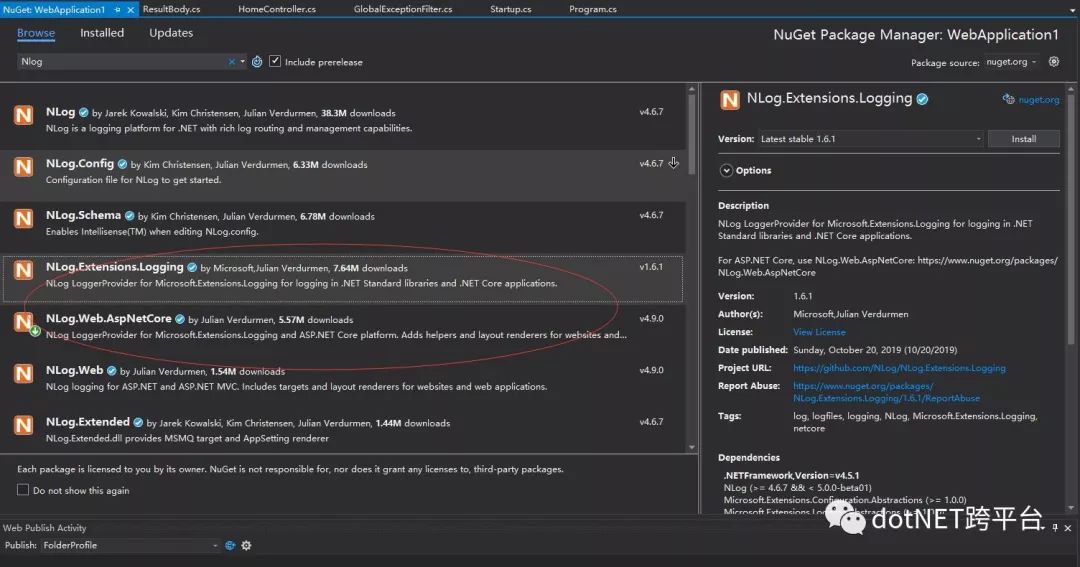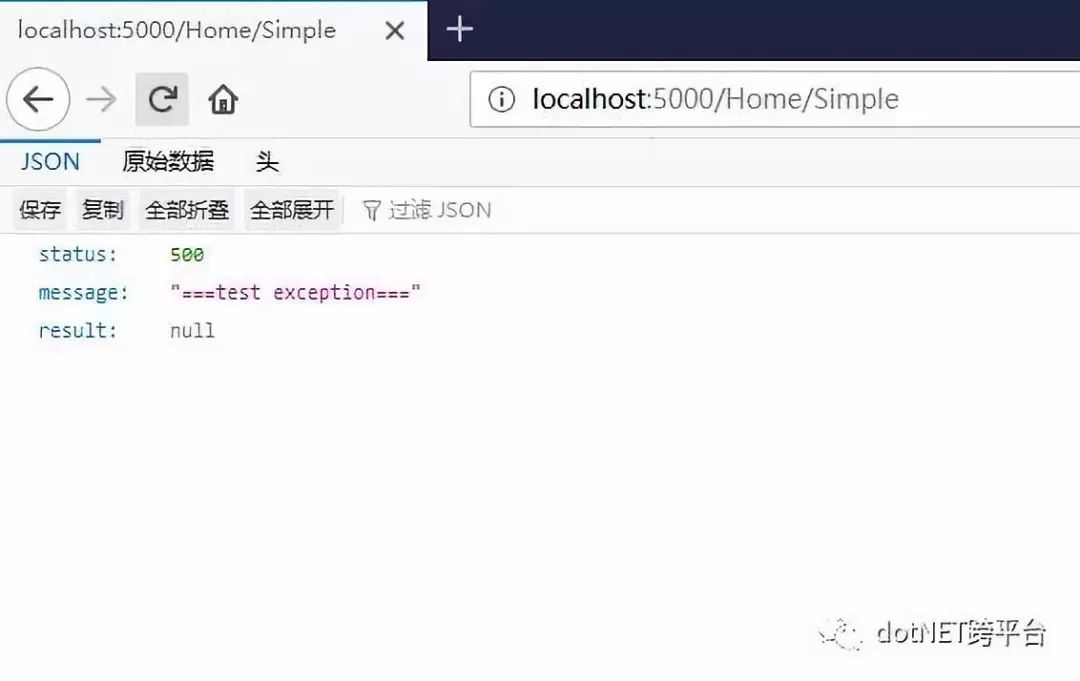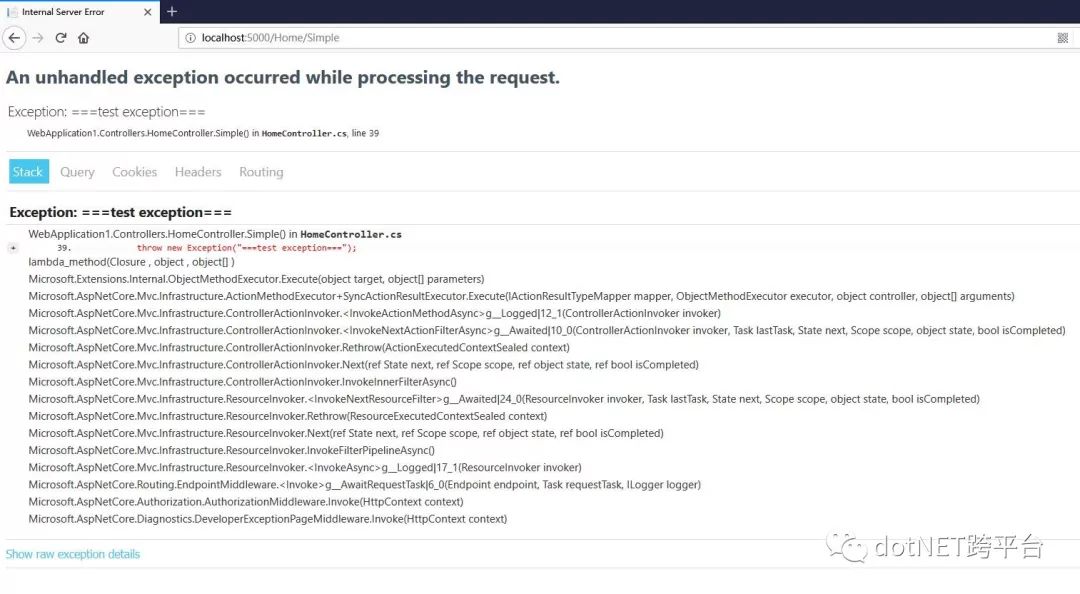前言
系统异常监控可以说是重中之重,系统不可能一直运行良好,开发和运维也不可能24小时盯着系统,系统抛异常后我们应当在第一时间收到异常信息。在Asp.net Core里我使用拦截器和中间件两种方式来监控异常。全局异常监控的数据最好还是写入数据库,方便查询。
配置NLog

NLog配置文件
<?xml version="1.0" encoding="utf-8"?>
<nlog xmlns="http://www.nlog-project.org/schemas/NLog.xsd"xmlns:xsi="http://www.w3.org/2001/XMLSchema-instance"autoReload="true"internalLogLevel="info"internalLogFile="d:\temp\internal-nlog.txt"><!-- the targets to write to --><targets><!-- write logs to file --><target xsi:type="File" name="allfile" fileName="d:\temp\nlog-all-${shortdate}.log"layout="${longdate}|${event-properties:item=EventId.Id}|${uppercase:${level}}|${logger}|${message} ${exception}" /><!-- another file log, only own logs. Uses some ASP.NET core renderers --><target xsi:type="File" name="ownFile-web" fileName="d:\temp\nlog-own-${shortdate}.log"layout="${longdate}|${event-properties:item=EventId.Id}|${uppercase:${level}}|${logger}|${message} ${exception}|url: ${aspnet-request-url}|action: ${aspnet-mvc-action}" /><!-- write to the void aka just remove --><target xsi:type="Null" name="blackhole" /></targets><!-- rules to map from logger name to target --><rules><!--All logs, including from Microsoft--><logger name="*" minlevel="Trace" writeTo="allfile" /><!--Skip Microsoft logs and so log only own logs--><logger name="Microsoft.*" minlevel="Trace" writeTo="blackhole" final="true" /><logger name="*" minlevel="Trace" writeTo="ownFile-web" /></rules>
</nlog>注入NLog
在Program.cs里注入NLog依赖,添加依赖前需要导入两个命名空间Microsoft.Extensions.Logging、 NLog.Web。
public class Program
{public static void Main(string[] args){CreateHostBuilder(args).Build().Run();}public static IHostBuilder CreateHostBuilder(string[] args) =>Host.CreateDefaultBuilder(args).ConfigureWebHostDefaults(webBuilder =>{webBuilder.UseStartup<Startup>();}).ConfigureLogging(logging=>{logging.ClearProviders();logging.SetMinimumLevel(Microsoft.Extensions.Logging.LogLevel.Trace);}).UseNLog();
}拦截器
在Asp.Mvc里最常用的拦截器,在Asp.net Core里也是支持的。先定义拦截器,再注入拦截器,这里自定义拦截器实现接口IExceptionFilter,接口会要求实现OnException方法,当系统发生未捕获的异常时就会触发这个方法。这里全局异常信息最好能放入数据库里,方便后台查询,再就是抛异常后最好能给负责人发邮件和发送报警短信,也可以直接拨打电话。
public class GlobalExceptionFilter : IExceptionFilter
{private IWebHostEnvironment _env;private ILogger<GlobalExceptionFilter> _logger;public GlobalExceptionFilter(IWebHostEnvironment _env,ILogger<GlobalExceptionFilter> _logger){this._env = _env;this._logger = _logger;}public void OnException(ExceptionContext context){if (context.Exception.GetType() == typeof(BusException)){//如果是自定义异常,则不做处理}else{}//日志入库//向负责人发报警邮件,异步//向负责人发送报警短信或者报警电话,异步Exception ex = context.Exception;//这里给系统分配标识,监控异常肯定不止一个系统。int sysId = 1;//这里获取服务器ip时,需要考虑如果是使用nginx做了负载,这里要兼容负载后的ip,//监控了ip方便定位到底是那台服务器出故障了string ip = context.HttpContext.Connection.RemoteIpAddress.ToString();_logger.LogError($"系统编号:{sysId},主机IP:{ip},堆栈信息:{ex.StackTrace},异常描述:{ex.Message}");context.Result = new JsonResult(ResultBody.error(ex.Message));context.ExceptionHandled = true;}
}在Startup.ConfigureServices方法里注入全局异常处理拦截器。
public void ConfigureServices(IServiceCollection services)
{services.AddControllersWithViews();//注入全局异常处理services.AddMvc(option =>{option.Filters.Add(typeof(GlobalExceptionFilter));});
} OK,定义了拦截器后,我们自己抛一个未捕获的异常试试。如图,都会返回统一的JSON返回值。


中间件
定义中间件,定义中间件时先导入日志命名空间Microsoft.Extensions.Logging。
public class GlobalExceptionMiddleware
{private readonly RequestDelegate next;private ILogger<GlobalExceptionMiddleware> logger;public GlobalExceptionMiddleware(RequestDelegate next, ILogger<GlobalExceptionMiddleware> logger){this.next = next;this.logger = logger;}public async Task Invoke(HttpContext context){try{await next.Invoke(context);}catch (Exception ex){await HandleExceptionAsync(context, ex);}}private async Task HandleExceptionAsync(HttpContext context, Exception e){if (e.GetType() == typeof(BusException)){//如果是自定义异常,则不做处理}else{}//记日志int sysId = 1;string ip = context.Connection.RemoteIpAddress.ToString();logger.LogError($"系统编号:{sysId},主机IP:{ip},堆栈信息:{e.StackTrace},异常描述:{e.Message}");string result = System.Text.Json.JsonSerializer.Serialize(ResultBody.error(e.Message));await context.Response.WriteAsync(result);}
}在Startup.Configure方法里注册中间件。
public void Configure(IApplicationBuilder app, IWebHostEnvironment env,ILoggerFactory loggerFactory)
{if (env.IsDevelopment()){app.UseDeveloperExceptionPage();}else{app.UseExceptionHandler("/Home/Error");}//注册异常处理中间件app.UseMiddleware<GlobalExceptionMiddleware>();app.UseStaticFiles();app.UseRouting();app.UseAuthorization();app.UseEndpoints(endpoints =>{endpoints.MapControllerRoute(name: "default",pattern: "{controller=Home}/{action=Index}/{id?}");});
}中间件这里处理异常最后向客户端响应写入了一个字符串,这是个拦截器处理方式不同的地方。当然对客户端或者前端来说还是JSON对象更直观些。
参考链接
https://www.cnblogs.com/suizhikuo/p/8822352.html
原文链接:https://www.cnblogs.com/sword-successful/p/11771858.html
.NET社区新闻,深度好文,欢迎访问公众号文章汇总 http://www.csharpkit.com





)


)











